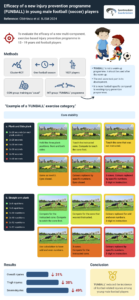We recently published a cluster-randomised controlled trial (cluster-RCT) in BJSM. It investigated the efficacy of a new injury prevention programme (IPP) called ‘FUNBALL’ in reducing the injuries in youth male football players (1). The summary of this study is outlined in this blog.
Why is this study important?
The importance of injury prevention in football is well documented. Several IPPs have been investigated for their efficacy; however, despite promising results in injury reduction (2-4), evidence remains conflicting (5, 6). Furthermore, studies consistently emphasize the challenges associated with low adherence to the IPPs (7-10).
The ‘FUNBALL’ programme was developed specifically for youth footballers with the intention of incorporating as many football-specific elements as possible. End-users participated in the development phase. Each exercise category includes two different exercises to increase variability, and all exercises are organized into progressive levels. To address adherence issues, the ‘FUNBALL’ programme incorporates exercises that allow for competition between players. Cognitive challenges are included in the majority of exercises, and the ball is included as often as possible. Finally, contrary to existing IPPs, the ‘FUNBALL’ programme is designed to be used after the usual warm-up.
How did the study go about this?
1027 young male football players from Kosovo who were competing in the Under (U) 15, U17, and U19 age groups were randomised either in the intervention (INT) or in the control (CON) group. The INT group (524 players) performed the ‘FUNBALL’ programme in addition to their usual training, at least twice per week. The CON group (503 players) continued their regular training routine. Both groups were followed for one football season (2021-2022). On a weekly basis, injuries, exposure hours, and compliance with the programme were reported to the research staff.
What did the study find?
We found a 31% lower injury incidence in the INT group regarding the overall number of time-loss football-related injuries. The thigh injury incidence was lowered by 38%. The incidence of moderate injuries (time loss between 7 and 28 days) was lowered by 35%, and of severe injuries (time loss >28 days) by 49%. The injury burden was 40 days lost per 1000 football hours in the INT group compared to 74 days lost per 1000 football hours in the CON group, thus leading to a higher player availability in the INT group.
What are the key take-home points?
The ‘FUNBALL’ programme lowered the incidence rate for overall injuries, for thigh injuries, for moderate and severe injuries by 31-49% when was implemented for one football season. Considering that the ‘FUNBALL’ programme contains more football-specific elements compared to existing IPPs, it might increase chances that coaches will choose this programme in the first place and the potential to a higher adherence rate in the long(er) run.

References
- Obërtinca R, Meha R, Hoxha I, et alEfficacy of a new injury prevention programme (FUNBALL) in young male football (soccer) players: a cluster-randomised controlled trialBritish Journal of Sports Medicine Published Online First: 18 March 2024.
- Crossley KM, Patterson BE, Culvenor AG, et al. Making football safer for women: a systematic review and meta-analysis of injury prevention programmes in 11 773 female football (soccer) players. Br J Sports Med 2020;54:1089–98.
- Lemes IR, Pinto RZ, Lage VN, et al. Do exercise-based prevention programmes reduce non-contact musculoskeletal injuries in football (soccer)? A systematic review and meta-analysis with 13 355 athletes and more than 1 million exposure hours. Br J Sports Med 2021;55:1170–8.
- van Dyk N, Behan FP, Whiteley R. Including the Nordic hamstring exercise in injury prevention programmes halves the rate of hamstring injuries: a systematic review and meta-analysis of 8459 athletes. Br J Sports Med 2019;53:1362–70.
- Obërtinca R, Hoxha I, Meha R, et al. Efficacy of multi-component exercise-based injury prevention programs on injury risk among footballers of all age groups. A systematic review and meta-analysis. Sports Med 2023;53:837–48.
- Impellizzeri FM, McCall A, van Smeden M. Why methods matter in a meta-analysis: a reappraisal showed inconclusive injury preventive effect of Nordic hamstring exercise. J Clin Epidemiol 2021;140:111–24.
- Bizzini M, Dvorak J. FIFA 11+: an effective programme to prevent football injuries in various player groups worldwide—a narrative review. Br J Sports Med 2015;49:577–9.
- Lindblom H, Waldén M, Carlfjord S, et al. Implementation of a neuromuscular training programme in female adolescent football: 3-year follow-up study after a randomised controlled trial. Br J Sports Med 2014;48:1425-30.
- O’Brien J, Young W, Finch CF. The delivery of injury prevention exercise programmes in professional youth soccer: Comparison to the FIFA 11+. J Sci Med Sport 2017;20:26-31.
- Bizzini M, Junge A, Dvorak J. Implementation of the FIFA 11+ football warm up program: how to approach and convince the football associations to invest in prevention. Br J Sports Med 2013;47:803–6.
Authors and affiliations
Rilind Obërtinca (1,2), Rina Meha (1), Ilir Hoxha (3,4), Bujar Shabani (5,6), Tim Meyer (1), Karen aus der Fünten (1)
- Institute of Sports and Preventive Medicine, Saarland University, Saarbrucken, Germany
- Department of Physiotherapy, University ‘Fehmi Agani’ in Gjakova, Gjakova, Kosovo
- The Dartmouth Institute for Health Policy and Clinical Practice, Geisel School of Medicine at Dartmouth, Lebanon, NH, USA
- Evidence Synthesis Group, Prishtina, Kosovo
- Faculty of Medicine, University of Prishtina, Prishtina, Kosovo
- Université Claude Bernard, Lyon, France